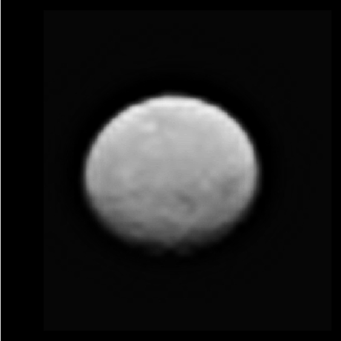Dawn has dwarf planet Ceres in its sight
Images of the approach of NASA's spacecraft Dawn to the celestial body images suggest features such as large craters on the body's surface

Ceres in sight: the camera system onboard of spacecraft DAWN captured this image of the dwarf planet from a distance of 380,000 kilometres, this corresponds roughly to the distance between the Earth and the moon. After careful image processing, features on the surface of Ceres become quite clear.
The dwarf planet Ceres is a mysterious world, about which little is known. With a diameter of about 950 kilometers and a nearly spherical shape Ceres is more reminiscent of a planet than of the much smaller and irregularly shaped asteroids. Scientist deem it possible that 4.5 billion years ago, Ceres was on the best way to becoming a full-fledged planet – and got stuck in the middle of this evolution. Thus, in Ceres an early state of our solar system is preserved. In addition, the body's composition may well be as fascinating as its past: beneath the surface researchers suspect a frozen or maybe even liquid layer of water.
In the current images Ceres covers 27 pixels. “Already, the images hint at first surface structures such as craters”, says Dr. Andreas Nathues from the MPS, Framing Camera Lead Investigator. A striking bright spot can also be discerned. After careful image processing, these structures become even clearer. Due to the optical design of the camera system, the data surpass all previously known images in the resolution of these details. “We have identified all of the features seen by Hubble on the side of Ceres we have observed, and there are also suggestions of remarkable structures awaiting us as we move even closer,” says Nathues.
"It is exciting to see the surface of a new world slowly come into view," said Dr. Mark Sykes, CEO of the Planetary Science Institute in Tucson (USA), and a member of the Dawn Science Team. "Just confirming features observed by Hubble ten years earlier is important. With the recent detection of water vapor emission by Herschel Space Observatory, we will be looking for evidence of cryovolcanism and other processes to explain it.” The researchers soon want to check whether Ceres is accompanied by smaller moons, and use the Framing Cameras’ color filters to get a first impression of the surface composition. "We are on the verge of testing hypotheses about an ice-rich surface resulting in relaxed equatorial craters and seeing if there are tectonics and other structures that will give us clues about interior oceans.”, says Nathues.
In September 2007 the Dawn spacecraft embarked on its journey to the asteroid belt which lies between the orbits of Mars and Jupiter. In 2011, the mission reached the asteroid Vesta and accompanied it for more than a year. MPS-scientists have succeeded in creating precise color maps of the asteroid and proven, among other things, that some materials on its surface did not originate from Vesta itself, but reached the asteroid by means of impacts. Since September 2012 Dawn has been en route to Ceres. After the camera system has pointed its gaze at starfields for more than two years, it is now again obtaining images of a target object on a regular basis.
****************************
The Dawn mission to Vesta and Ceres is managed by NASA’s Jet Propulsion Laboratory for NASA's Science Mission Directorate (SMD), Washington. It is a project of the Discovery Program, managed for SMD by NASA'sMarshall Space Flight Center, Huntsville, Ala. The University of California, Los Angeles, is responsible for overall Dawn mission science. Orbital Sciences Corporation of Dulles, Va., designed and built the Dawn spacecraft. The framing cameras have been developed and built under the leadership of the Max Planck Institute for Solar System Research, Göttingen, Germany, with significant contributions by the German Aerospace Center (DLR) Institute of Planetary Research, Berlin, and in coordination with the Institute of Computer and Communication Network Engineering, Braunschweig. The framing camera project is funded by the Max Planck Society, DLR, and NASA.
